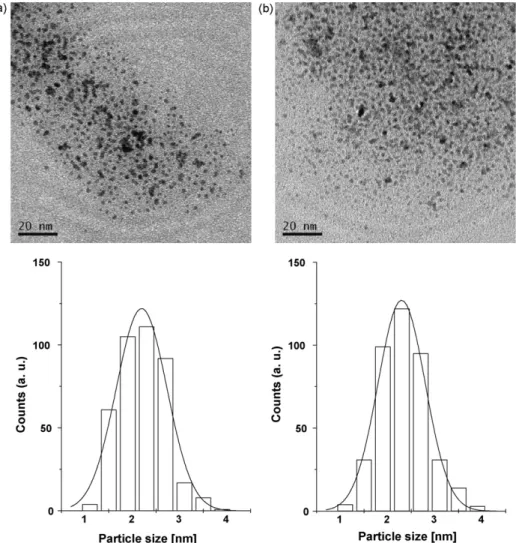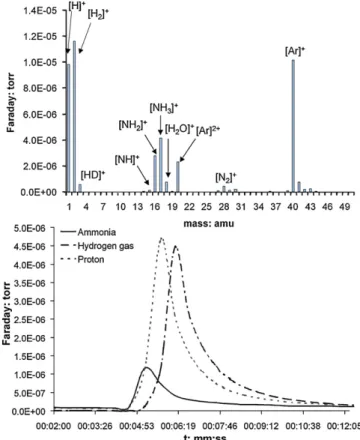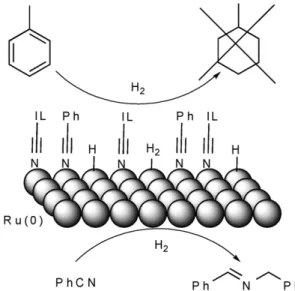Contents lists available atScienceDirect
Journal of Molecular Catalysis A: Chemical
j o u r n a l h o m e p a g e :w w w . e l s e v i e r . c o m / l o c a t e / m o l c a t a
Tuning the selectivity of ruthenium nanoscale catalysts with functionalised ionic liquids: Hydrogenation of nitriles
Martin H.G. Prechtl, Jackson D. Scholten, Jairton Dupont
∗Laboratory of Molecular Chemistry, Institute of Chemistry, Universidade Federal do Rio Grande do Sul, Av. Bento Gonc¸alves 9500, 91501-970 Porto Alegre, RS, Brazil
a r t i c l e i n f o
Article history:
Received 24 June 2009
Received in revised form 4 August 2009 Accepted 4 August 2009
Available online 12 August 2009
Keywords:
Ru catalysts Ru nanoparticles Ionic liquids Hydrogenation Nitrile Arenes
a b s t r a c t
Ruthenium nanoparticles prepared in nitrile-functionalised ionic liquids (ILs) display unusual selectivities toward the hydrogenation of nitrile containing aromatic compounds. In particular, a selective catalytic hydrogenative coupling of nitriles was observed. In this transformation, nitrile groups are exclusively hydrogenated in the presence of arenes, which are typically hydrogenated by ruthenium nanoparticles in non-functionalised ILs. The catalyst material was characterised by means of TEM and EDS analysis.
Furthermore, molecular species formed during the catalytic process were characterised by MS-analysis of the gaseous phase and the ionic liquid phase by ESI/MS Q-TOF.
© 2009 Elsevier B.V. All rights reserved.
1. Introduction
Catalytic hydrogenation and dehydrogenation reactions play an important role in both industrial processes and academic research [1]. In recent years, the progress in the catalytic hydrogenation of multiple carbon–carbon and carbon–heteroatom bonds by solu- ble metal nanoparticles (MNPs) has seen remarkable growth[2].
In most cases, these MNPs display typical surface-like (heteroge- neous) catalytic properties rather than single site (homogeneous) catalytic properties[3,4]. For example, the hydrogenation of O- substituted arenes such as anisole by Ir(0) nanoparticles occurs with concomitant hydrogenolysis of the C–O bond. Hydrogenation of the aromatic ring takes place preferentially in ketone-containing aromatic compounds[5,6]. However, it is evident that the surface properties of soluble MNPs can be modulated by the addition of ligands akin to classical coordination catalysis, as is observed in enantioselective allylic alkylation catalysed by palladium nanopar- ticles modified with chiral xylofuranoside diphosphites. Under these reaction conditions, the catalysts provided different selec- tivity than typically observed for monometallic catalysts [7].
Herein, we report that the catalytic surface properties of ruthe- nium nanoparticles in ILs can be tuned by the use of nitrile containing ligand/substrates. In particular, a clean hydrogenative
∗ Corresponding author. Tel.: +55 51 33086321; fax: +55 51 33087304.
E-mail address:jairton.dupont@ufrgs.br(J. Dupont).
coupling reaction of benzonitrile by aminolysis to provide (E)- N-benzylidene-1-phenylmethanamine takes place without arene hydrogenation[8].
For the present study, we chose nitrile-functionalised 1-buty- ronitrile-3-methylimidazolium bis(trifluoromethane-sulfonyl)- imidate ionic liquid1(Fig. 1), since it may stabilise the ruthenium nanoscale catalyst via nitrile binding without blocking the coor- dination of the substrates. Indeed, this ionic liquid was readily prepared and successfully applied by Dyson and co-workers for cross-coupling reactions by Pd nanoparticles[9,10].
2. Experimental
2.1. General methods: reagents, reactors and analyses techniques
All manipulations involving the ruthenium complexes were car- ried out under an argon atmosphere using Schlenk techniques.
[Ru(COD)(2-methylallyl)2] was obtained from Sigma–Aldrich and used without further purification. The IL (BCN)MI·NTf2 was pre- pared according to known procedures[9,11], dried at 70◦C over night under reduced pressure, and stored under argon. Benzoni- trile was degassed and stored under argon prior to use. All the other chemicals were purchased from commercial sources and used without further purification. NMR spectra were recorded on a Var- ian VNMR spectrometer (300 MHz). Mass spectra were obtained using an ESI/MS micromass Q-TOFmicro and HIDEN QIC-20 quadrupole mass spectrometer gas-analyser. Gas chromatogra- 1381-1169/$ – see front matter© 2009 Elsevier B.V. All rights reserved.
doi:10.1016/j.molcata.2009.08.004
Fig. 1.Imidazolium IL1(BCN)MI·NTf2with a pendant nitrile functionality in the side-chain, which served as a stabilising group and a ruthenium precursor,2.
phy analyses were performed with a Hewlett–Packard-5890 gas chromatograph with an FID and a 30 m capillary column with a dimethylpolysiloxane stationary phase. Transmission electron microscopy (TEM) and EDS were performed on a JEOL–JEM 2010 operating at 200 kV with a magnification of 150 k. The nanoparti- cle formation and catalytic hydrogenation reactions were carried out in a modified stainless steel reactor (4–25 bar) or modified Fischer–Porter bottle (4 bar) with a glass insert immersed in a sil- icone oil bath and pressurised with hydrogen gas (4–25 bar). The substrates were added with a gas-tight precision syringe (2 mL).
The temperature was maintained at 50◦C and 90◦C by a hot- stirring plate connected to a digital controller (ETS-D4 IKA). The catalyst/substrate ratios were calculated from the initial quantity of [Ru(COD)(2-methylallyl)2] used.
2.2. Synthesis of ruthenium nanoparticle in ionic liquids
A stainless steel reactor was loaded with [Ru(COD)(2- methylallyl)2] (45 mg, 141mol) under a flow of argon. Next,
(BCN)MI·NTf2 (0.3 mL) was added via syringe under an argon flow. The mixture was stirred at room temperature for 60 min resulting in a turbid dispersion. The system was heated to 50◦C, and hydrogen (4 bar) was admitted to the system. After stir- ring for 18 h, a black suspension was obtained. The reactor was kept under reduced pressure to remove the formed cyclooc- tane and isobutane. The Ru nanoparticles embedded in the IL were analysed by TEM and used for subsequent catalytic experi- ments.
2.3. Catalytic hydrogenation of nitriles
Benzonitrile (2.0 mL, 19.4 mmol) was added to an ionic catalytic solution obtained as previously described, and the reactor was pres- surised with 25 bar hydrogen gas at room temperature and heated to 90◦C (27 bar) for 22 h. Next, a gas sample was analysed with a MS quadrupole by connecting the reactor to the gas-analyser. The reac- tor was cooled to room temperature, pressure was released, and the reaction mixture was extracted with pentane (5×2 mL).CAUTION:
The pressure should be released carefully in a well-ventilated fume- hood because significant amounts of odorous and toxic ammonia is set free!Samples of the organic layer were analysed by NMR and GC, with both methods indicating 70% conversion, and NMR con- firmed this conversion by analysis of the crude reaction mixture.
The Ru/IL-phase was analysed by ESI/MS and TEM. Catalysis with toluene was performed in a similar manner, but toluene was readily quantitatively isolated by condensation at reduced pressure into a cold-trap.
Fig. 2.Ru-NPs: (a) before catalysis (2.2±0.5 nm) and (b) after catalysis (2.3±0.5 nm) in IL (BCN)MI·NTf2.
2.4. Sample preparation for TEM analysis
In order to perform TEM analysis, a drop of the suspension con- taining the Ru nanoparticles embedded in the IL was dispersed in isopropanol, and a small quantity of this dispersion was placed on a carbon-coated copper grid. Particle size distributions were deter- mined from digital images. Nanoparticle diameters were estimated from ensembles of 200 particles (400 counts) chosen in arbitrary areas of the enlarged micrographs. The diameters of the particles in the micrographs were measured using Sigma Scan Pro 5.
3. Results and discussion
The treatment of [Ru(COD)(2-methylallyl)2] 2 (COD = 1,5- cyclooctadiene) with hydrogen gas in (BCN)MI·NTf2 1 leads to the formation of stable and small-sized Ru-NPs (2.2±0.5 nm, Fig. 2). The dimensions of the Ru-NPs in (BCN)MI·NTf2 were comparable to those prepared in BMI·NTf2 (2.1 nm; 1-n-butyl- 3-methylimidazolium bis(trifluoromethane-sulfonyl)imidate) and DMI·NTf2 (2.1 nm; 1-n-decyl-3-methylimidazolium bis(trifluoromethane-sulfonyl)imidate)[12]. This result highlights capability of (BCN)MI·NTf2to keep the Ru-NPs well dispersed and with low agglomeration. Although the nitrile group is maintained during the synthesis of the Ru-NPs (4 bar H2, 50◦C, 18 h), it reacts after 5 days to provide primarily the reductive coupling product (see below). Most importantly, contrary to earlier observations of Ru-NPs dispersed in BMI·NTf2 [12], these Ru-NPs are inactive toward the hydrogenation of aromatic compounds such as toluene, even under moderately forcing conditions (25 bar H2 and 90◦C).
However, under these reaction conditions, the reductive nitrile condensation product6was obtained in good yields (Scheme 1).
Furthermore, the treatment of the Ru-NPs in (BCN)MI·NTf2in the presence of benzonitrile yields preferentially (E)-N-benzylidene- 1-phenylmethanamine5. As indicated by the histograms inFig. 2, the mean particle size (2.2–2.3±0.5 nm) remained unchanged within the standard variation (0.5 nm) before (2.2 nm) and after catalysis (2.3 nm).
Analysis of the IL-phase by ESI(+)/MS and13C NMR confirmed the hydrogenative coupling of the nitrile group. Importantly, the ESI(+)/MS-analysis provided detailed insight into the overall reac- tion pathway of the nitrile hydrogenation of IL1, as well as into the catalytic hydrogenation of benzonitrile (Scheme 1). Analysis of a reaction sequence indicated the presence of unreacted IL1, with (m/z) M+150.11 after 18 h at 50◦C and 4 bar H2. Next, at 90◦C and 25 bar H2, the ESI(+)/MS spectrogram showed four distinct species (Fig. 3): IL1(150.15, M+), IL3(154.18, M+; 77.59, M2+, IL-amine), IL 7(137.15, M+, –NH3), and IL6(145.66, M2+; 97.44, M3+, condensed dimer). This indicated that the Ru-NPs first catalysed the hydro- genation of the aliphatic nitrile to a primary amine (IL3), followed by subsequent aminolysis, resulting in the secondary imine IL6and in IL7.
The ESI(+)/MS of the catalytic hydrogenation of benzonitrile showed IL 1 (150.07, M+), (E)-N-benzylidene-1- phenylmethanamine5(196.08, M+) and the IL4 (242.24). Most likely, (E)-N-benzylidene-1-phenylmethanamine5was detectable by ESI(+)/MS due to protonation from residual water content from the solvent (MeCN) used for this analysis. It is interesting to note that no benzylamine (protonated or not) was observed neither by ESI-MS or 1H NMR indicating that such species are highly reactive undergoing rapidly coupling process to yield 5.
As such, the overall reaction pathway likely involves aminolysis, since ammonia was detected in the gaseous phase of the reactor during the benzonitrile hydrogenation by a MS Q-TOF gas-analyser (Fig. 4). The detected fragmentation of the sample is concurrent to the MS data listed in the literature (NIST). By time-resolved
Fig. 3. ESI(+) spectrum of the hydrogenation of imidazolium IL1(BCN)MI·NTf2
(top) and hydrogenation of benzonitrile forming (E)-N-benzylidene-1- phenylmethanamineand IL-4(bottom).
Fig. 4. MS spectrogram of the online analysis of the gaseous phase (top), and the time-resolved gas-injection monitoring of the M+of ammonia and hydrogen gas (bottom).
Scheme 1.Reaction pathways of the nitrile hydrogenation in the presence and in the absence of benzonitrile.
gas-injection monitoring of the M+of ammonia and hydrogen gas, it is clearly shown that a significant amount of ammonia is formed in relation to the excess hydrogen gas. Considering the described reaction pathway inScheme 1and the quantification of5by GC (70%; catalyst-system was recycled for three runs under identical conditions), the detection of ammonia by MS Q-TOF is related to a concentration of 6.8 mmol NH3extruded by aminolysis.
It is likely that in these systems the nitrile group is strongly coordinated to the ruthenium surface and is not easily displaced by the aromatic ring of toluene or benzonitrile. This selectiv- ity is the opposite of that observed for the hydrogenation of aromatic ketones, in which the arene groups are preferentially hydrogenated[6]. In order to further confirm our hypothesis that the selectivity depends on the functional group of the IL1 and not on the ruthenium nanoparticles, the arene hydrogenation catalyst-system Ru-NPs/BMI·NTf28was tested for hydrogenation of benzonitrile under conditions identical to the Ru/(BCN)MI·NTf2 system. System 8 catalyses the reaction of benzonitrile to (E)- N-benzylidene-1-phenylmethanamine5in 65% yield. This result indicates that the selectivity of the Ru-NPs/(BCN)MI·NTf2 system likely depends on the IL support and not on the ruthenium nano- material.
It is possible that the true catalyst might be a molecular ruthe- nium species with IL-1acting as ligand, with the Ru-NPs simply acting as a reservoir for ruthenium atoms [13–15]. This might explain the exclusive hydrogenation of the nitrile, in which ruthe- nium polyhydride complexes are active for nitrile hydrogenation [16], while examples for molecular catalysts for arene hydrogena- tion are rare[17]. To provide support for this molecular pathway, we attempted to hydrogenate benzonitrile in the absence of IL under the reaction conditions in which the benzonitrile could only be hydrogenated by the molecular ruthenium precursor 2; this reaction was unsuccessful. The present Ru-NPs do not show activity for arene hydrogenation, while other ILs Ru-NPs are active toward arene hydrogenation[12,18,19]. Additionally, the activation energy for toluene hydrogenation with ruthenium catalysts in IL is approx- imately 20% lower than the activation energy for hydrogenation of nitrile groups in ILs[8,12]. These results strongly indicate that the presence of the nitrile group in the IL side-chain influences the interaction between the Ru-NP surfaces and a corresponding sub- strate. The nitrile group of the IL coordinates as a ligand to the metal surface, forming an IL-layer and causing the surface to be blocked for coordination by arenes, since nitriles are known to strongly adsorb to solid metal catalysts[20,21]. Therefore, substrates bear-
Fig. 5.Model depicting the Ru-NPs protected by a layer of (BCN)MI·NTf2and sub- strate nitriles, where nitriles are hydrogenated and arenes are not.
ing a nitrile group coordinated preferentially to the metal surface via ligand exchange, and arenes are unable to contact the catalyst (Fig. 5).
Moreover, it is well known that the hydrogenation of PhCN to benzylamine is catalysed by molecular complexes[22–24]. In the case of metal surfaces[20,21,25]the activated amine – benzy- lamine – is rapidly transformed into the benzylidene benzylamine via aminolysis and coupling although we were unable to detect neither benzylamine nor benzylimine by ESI-MS and NMR experi- ments. As already pointed out benzylamine undergoes exclusively aminolysis with solid catalysts, in contrast molecular catalysts give benzylamine as main product[22–24].
4. Conclusions
In conclusion, we have illustrated the influence of nitrile- functionalised ILs for the synthesis and application of ruthenium nanoscale catalysts, previously designed for arene hydrogenation in non-functionalised ILs. Both systems (Ru-NPs/(BCN)MI·NTf2and Ru-NPs/BMI·NTf2) are active toward the hydrogenation of nitriles.
Using IL1, the inherent functionality of the IL tunes the selectiv- ity of the hydrogenation catalyst, preventing arene hydrogenation.
However, nitriles remain competent substrates for hydrogenation.
We propose that the selectivity for hydrogenation of other func-
tional groups can be influenced in a similar manner by this class of functionalised IL support. Our ongoing studies are aimed at improv- ing the selectivity of hydrogenations of aliphatic nitriles to primary amines, and our results will be reported in due course.
Acknowledgements
The authors thank the Alexander-Von-Humboldt Foundation (Dr. M.H.G. Prechtl), CNPq, INCT-Catal., Petrobras, and CAPES for funding.
References
[1] P.G. Jessop, R.H. Morris, Coord. Chem. Rev. 121 (1992) 155–284.
[2] D. Astruc, F. Lu, J.R. Aranzaes, Angew. Chem.-Int. Edit. 44 (2005) 7852–7872.
[3] A. Roucoux, J. Schulz, H. Patin, Chem. Rev. 102 (2002) 3757–3778.
[4] P. Migowski, J. Dupont, Chem.-Eur. J. 13 (2007) 32–39.
[5] G.S. Fonseca, A.P. Umpierre, P.F.P. Fichtner, S.R. Teixeira, J. Dupont, Chem.-Eur.
J. 9 (2003) 3263–3269.
[6] G.S. Fonseca, J.D. Scholten, J. Dupont, Synlett (2004) 1525–1528.
[7] S. Jansat, M. Gomez, K. Philippot, G. Muller, E. Guiu, C. Claver, S. Castillon, B.
Chaudret, J. Am. Chem. Soc. 126 (2004) 1592.
[8] For the hydrogenation of nitriles in ionic liquids see: K. Obert, D. Roth, M. Ehrig, A. Schönweiz, D. Assenbaum, H. Lange, P. Wasserscheid, Appl. Catal. A 356 (2009) 43–51.
[9] D.B. Zhao, Z.F. Fei, R. Scopelliti, P.J. Dyson, Inorg. Chem. 43 (2004) 2197–2205.
[10] Z.F. Fei, D.B. Zhao, D. Pieraccini, W.H. Ang, T.J. Geldbach, R. Scopelliti, C. Chiappe, P.J. Dyson, Organometallics 26 (2007) 1588–1598.
[11] C.C. Cassol, G. Ebeling, B. Ferrera, J. Dupont, Adv. Synth. Catal. 348 (2006) 243–248.
[12] M.H.G. Prechtl, M. Scariot, J.D. Scholten, G. Machado, S.R. Teixeira, J. Dupont, Inorg. Chem. 47 (2008) 8995–9001.
[13] M.T. Reetz, J.G. de Vries, Chem. Commun. (2004) 1559–1563.
[14] C.C. Cassol, A.P. Umpierre, G. Machado, S.I. Wolke, J. Dupont, J. Am. Chem. Soc.
127 (2005) 3298–3299.
[15] A.S. Gruber, D. Pozebon, A.L. Monteiro, J. Dupont, Tetrahedron Lett. 42 (2001) 7345–7348.
[16] R.P. Beaty, R.A. Paciello, WO9623802-A (1996).
[17] P.J. Dyson, Dalton Trans. (2003) 2964–2974.
[18] E.T. Silveira, A.P. Umpierre, L.M. Rossi, G. Machado, J. Morais, G.V. Soares, I.L.R. Baumvol, S.R. Teixeira, P.F.P. Fichtner, J. Dupont, Chem.-Eur. J. 10 (2004) 3734–3740.
[19] T. Gutel, J. Garcia-Anton, K. Pelzer, K. Philippot, C.C. Santini, Y. Chauvin, B.
Chaudret, J.M. Basset, J. Mater. Chem. 17 (2007) 3290–3292.
[20] A. Chojecki, M. Veprek-Heijman, T.E. Muller, P. Scharringer, S. Veprek, J.A.
Lercher, J. Catal. 245 (2007) 237–248.
[21] P. Scharringer, T.E. Muller, J.A. Lercher, J. Catal. 253 (2008) 167–179.
[22] S. Enthaler, D. Addis, K. Junge, G. Erre, M. Beller, Chem.-Eur. J. 14 (2008) 9491–9494.
[23] S. Enthaler, K. Junge, D. Addis, G. Erre, M. Beller, ChemSusChem 1 (2008) 1006–1010.
[24] D. Addis, S. Enthaler, K. Junge, B. Wendt, M. Beller, Tetrahedron Lett. 50 (2009) 3654–3656.
[25] P. Scharringer, T.E. Muller, A. Jentys, J.A. Lercher, J. Catal. 263 (2009) 34–41.


